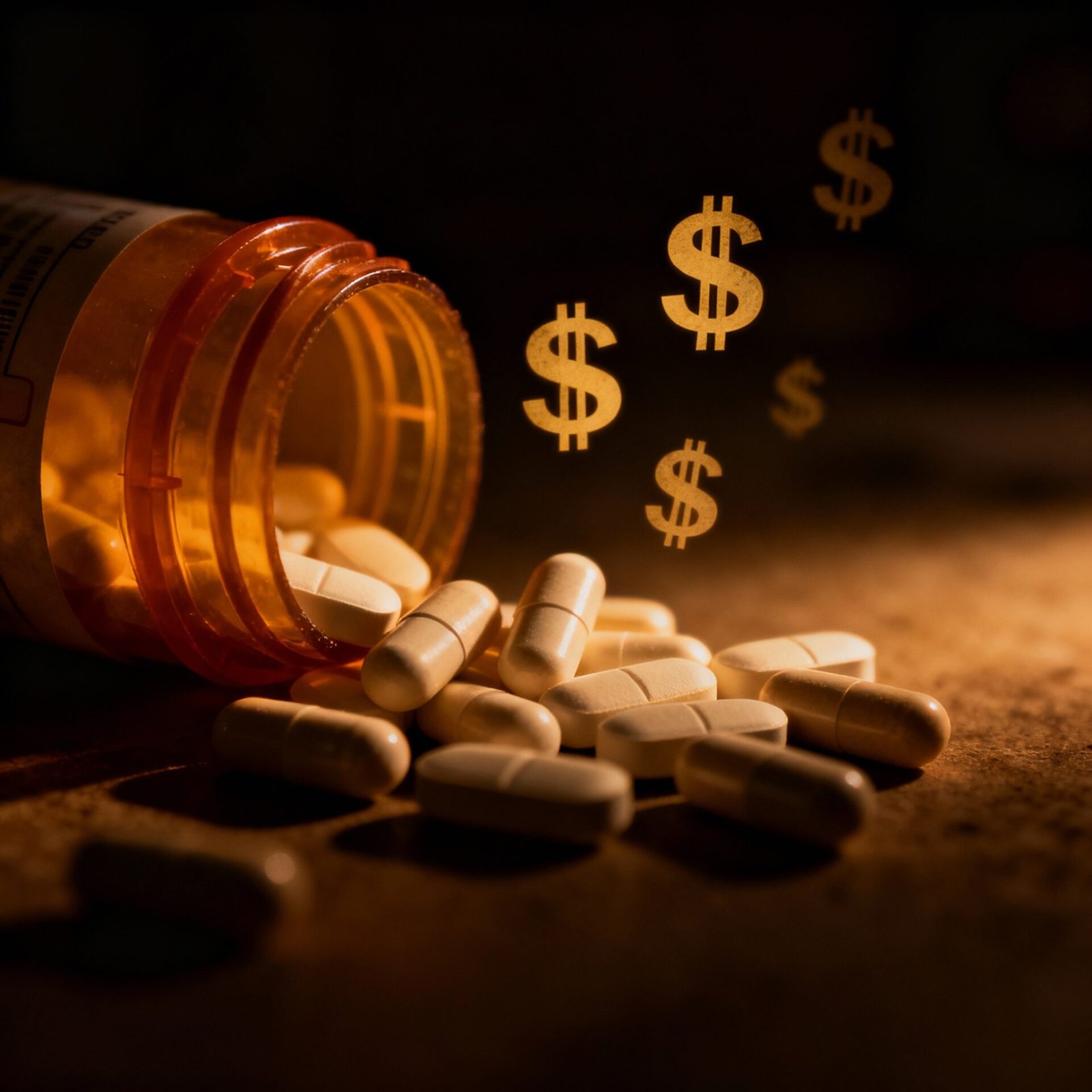Americans spend hundreds of billions on prescription drugs each year, yet life-saving medicines are often out of reach. In the United States, drug spending rose 330% over 20 years (1997–2017), far outpacing overall health spending (208%). Most Americans (78%) blame pharmaceutical profit motives i.e pharmaceutical price gouging in other words for high prices, and about one-third report skipping or rationing medicines due to cost.
This exposes a stark reality: U.S. companies set many drug prices unchecked by the government, creating what critics call a crisis of access. Senator Bernie Sanders captured the outrage in a recent hearing: “Why, in the richest country on Earth, do 1.3 million Americans ration insulin because of the cost?
Why are 1 out of 4 Americans not able to afford the prescription drugs their doctors prescribe?”.

This deep investigation uncovers how major drugmakers and their partners drive up prices on essential medications from diabetes and cancer drugs to HIV and antibiotics, enriching themselves at the expense of patients.
Insulin’s Iron Grip on Diabetics
Insulin, a nearly 100-year-old discovery, exemplifies the price gouging scandal. A bipartisan Senate Finance probe found insulin manufacturers (Lilly, Novo Nordisk, Sanofi) have “aggressively raised the list price” of insulin products even though “no meaningful innovation has occurred”. In practice, companies coordinated hikes so each rise by one was immediately matched by the others in a practice known as “shadow pricing”.
The result: Americans often pay hundreds of dollars per vial for insulin that costs manufacturers only a few dollars to maket. Texas Attorney General Ken Paxton’s 2024 lawsuit notes that a vial of synthetic insulin that cost $20 in the 1990s now lists for $300–$700, increases up to 1,000% in a decade.
Patients have paid a deadly price. CBS News documented families torn apart by insulin costs. Nicole Smith-Holt lost her 26-year-old son Alec in 2017 after he skipped insulin he couldn’t afford. With his insurance lapsed, Alec faced a $1,300 monthly cost, then disappeared. “He went home without insulin,” Smith-Holt said. “He died on June 27, 2017,” of diabetic ketoacidosis.
She warns that many Americans now make “life-and-death decisions daily: ‘Do I buy groceries or do I buy my insulin?’ and We hear horror stories every day”. Indeed, studies show millions of U.S. diabetics report rationing insulin or skipping doses because of price.
Lawmakers are alarmed. The same Senate investigation noted “a vicious cycle of price increases” driven by backroom deals between manufacturers and middlemen (PBMs). Senator Chuck Grassley said bluntly: “There is clearly something broken when a product like insulin which always skyrockets in price,” and that patients and taxpayers are paying the bill.
Other officials like Attorney General Paxton call it a “disturbing conspiracy” of companies and PBMs “intentionally…inflating the price of insulin”. Only under immense pressure have drugmakers pledged relief. In 2022 they agreed to cap many insulin co-pays at $35 for Medicare patients (per the Inflation Reduction Act), but by then billions had been extracted. States have begun capping out-of-pocket costs for all patients, yet federal leaders warn more reform is needed if Americans are to afford this decades-old lifesaver.
Epinephrine (EpiPen) and Other Monopolies
EpiPen (epinephrine auto-injector) became a national flashpoint for corporate greed. In 2007, the branded EpiPen two-pack cost about $100. By the mid-2010s, without any new ingredient or technology, Mylan (now Viatris) had hiked it to over $600, a six-fold increase.
Congress exploded when parents and schools could no longer afford the allergy medicine. At an Oversight Committee hearing in 2016, Rep. Elijah Cummings excoriated Mylan’s CEO: “This hearing is critical because yet another drug company, Mylan, has jacked up the price of a lifesaving product for no discernible reason to get filthy rich at the expense of our constituents.”
He warned Mylan execs: “After Mylan takes our punches, they’ll fly back to their mansion and laugh all the way to the bank while our constituents suffer, file for bankruptcy, and watch their children get sicker or die.”.
Investigations found Mylan exploited its monopoly and complex insurance rules. They led campaigns to force schools to stock EpiPens and kept competitors off formularies. In addition to congressional outrage, multiple state attorneys general investigated Mylan for antitrust abuse.
The price was so egregious that Mylan eventually offered a generic EpiPen and expanded patient assistance coupons but only after CEO Heather Bresch was publicly shamed and interrogated in Congress. The EpiPen scandal became emblematic of Pharma’s unchecked pricing. Similar stories have emerged for other monopoly drugs (like specialty epinephrine injectors), underscoring that corporate tactics and not R&D costs are the ones that often drive price spikes.
Hepatitis C and HIV Medications
In recent years, breakthrough treatments for viral diseases have carried astronomical price tags. Gilead Sciences’ Hepatitis C cure Sovaldi (approved 2013) was launched at $1,000 per pill ($84,000 for a 12-week course). Its successor Harvoni debuted at $94,500. Senate investigators concluded Gilead pursued these prices with “maximizing revenue” as the goal, “regardless of the human consequences.”
They noted Medicare spending on Hep C drugs jumped six-fold after Sovaldi’s launch. Senator Ron Wyden warned that if this model, six-figure launches for cures extends to cancer or Alzheimer’s drugs, it would make treatments “unaffordable and out of reach for millions”. (Wyden also emphasized that Gilead’s strategy ignored R&D costs, focusing instead on expanding Medicaid and Medicare billing)
Patients have felt this strain. Even with insurance, many Americans delayed or skipped Hepatitis C treatment when their co-pays or deductibles were thousands of dollars. HIV/AIDS medications have also seen heavy markups. For example, the HIV-prevention drug Truvada’s price rose over 150% since 2004, despite decades-old science. (New PrEP drugs like Descovy have similarly launched at high prices.) While foreign buyers often pay one-third the U.S. price for the same regimen, U.S. consumers bear the full burden under the current system. These cases illustrate that even life-saving innovation can be rationed by cost.
Cancer Drugs and Generic Inflation
Nearly every corner of oncology is affected. Older cancer medicines once costing a few dollars per dose have been repriced above $100 per pill. A striking example is lomustine, a 40-year-old chemotherapy for brain tumors. After being sold to a tiny company in 2013, its price soared nearly 1,400%. What was $50 per capsule under Bristol-Myers Squibb is now about $768.
Duke University neurosurgeon Henry Friedman called this “price-gouging”: patients simply “are not going to be able to afford it, or they’re going to pay a lot of money and have financial liability.”. A 2018 study found that prices for 24 patented injectable cancer drugs sold to Medicare rose ~18% above inflation every year for eight years. Even after generics appear, veterans say list prices often remain high, and insurers still shift costs to patients.
Generic drugs were supposed to bring prices down – yet many have been tainted by secret cartels. A sweeping 2019 lawsuit by Washington State (joined by 43 states) revealed 21 generic manufacturers colluded to inflate prices on 116 drugs like antibiotics, antidepressants and contraceptives. At the peak of the conspiracy, some generics saw price hikes over 1,000%, and one skyrocketed 2,700%.
Washington AG Bob Ferguson slammed the scheme as “one of the most damaging price-fixing conspiracies in history”, noting billions in overcharges. In 2023 the DOJ secured deferred prosecutions requiring Teva to pay $225 million and donate $50 million in drugs, marking the largest-ever antitrust fine for a pharma cartel. DOJ Antitrust chief Jonathan Kanter declared that regulators “will not hesitate to hold [drugmakers] accountable” for schemes that deprive Americans of affordable medicines. These cases show that the “Big Pharma” problem extends beyond brand-name companies to the generic sector too.
How the U.S. System Enables Pharmaceutical Price Gouging
America’s drug pricing regime lacks the checks found in other countries. Unlike virtually every other wealthy nation, the U.S. permits manufacturers to set high list prices and imposes no government negotiation for Medicare Part D or outpatients. Middlemen like pharmacy benefit managers (PBMs) and insurers then haggle for rebates behind closed doors, often rewarding higher list prices with bigger kickbacks.

This opaque system fuels ever-rising lists and copays. A recent RAND study found U.S. prices for brand-name drugs average over four times those in other nations. For all drugs combined, U.S. prices are ~278% of the international average; Canada’s drug prices are about 44% of U.S. levels. In effect, every new high U.S. price becomes a test of how far companies can push before lawmakers react.
Political influence sustains the status quo. The pharmaceutical industry outspent every other sector on lobbying in recent years. In 2021 drug firms shelled out over $390 million to lobby Congress, and PhRMA alone was the third-largest federal lobbying spender of any industry. Much of that went to block proposed price reforms, such as an international reference pricing plan (once included in H.R.3) that would have tied U.S. prices to a global average.
With this firepower, drug companies have minimized U.S. government intervention: even as the new Medicare drug law allows some negotiation (starting 2026) and caps insulin costs for seniors, other measures (like allowing negotiation for all drugs) were dropped. Pharmaceutical trade groups tout innovation funding as justification, but independent analysts note R&D costs are a small fraction of sales, and American patients still face prices far above what is paid abroad.
International Comparisons and the Path Forward
When compared globally, the U.S. stands out for its exorbitant prices. In Germany, France and Canada, governments negotiate or regulate drug costs to keep medicines affordable. A 2022 analysis found U.S. drug prices averaged 278% of prices in 33 other high-income countries. In Canada’s single-payer system, for example, the same insulin or cancer drug often costs a fraction of the U.S. list. Senator Chuck Grassley noted that while Europe’s prices are falling or stable, “our system is anything but a free market”, and it saddles American patients with costs their counterparts don’t face.
Today’s investigations echo reforms overseas. Many states have enacted caps on insulin co-pays and are monitoring drug manufacturer practices. Federally, the 2022 Inflation Reduction Act introduced a $35 insulin cap for Medicare and the first-ever Medicare price negotiations for select drugs. In 2024, the Senate announced that 98 drugs had been penalized for excessive price hikes under these new rules, yielding nearly $3 billion in savings to patients and taxpayers. “Big Pharma has been ripping off Americans by raising prices faster than inflation,” the Senate Finance report bluntly stated. This combination of fines, hearings, and legislation suggests a shift in the balance of power at least marginally back toward patients.
Still, much of the industry’s profit engine remains intact. Major drugmakers continue to enjoy patent protections, market exclusivities, and global price spreads that let them set U.S. prices sky-high. International cases have shown that when competition and government negotiation are absent, prices climb. Interviews with healthcare economists and legal experts warn that without deeper reform, new treatments (for Alzheimer’s, cancer, rare diseases) may follow the path laid by insulin and Hepatitis C cures, leaving only debt for most of the sick.
For now, the stories of those caught in the struggle continue to emerge: a diabetic parent skipping meals to afford insulin, a cancer patient mortgaging a home to cover a treatment course, an HIV-positive activist organizing for generic PrEP access. Their testimonies, combined with the corporate documents and hearings detailed above, paint a bleak picture of an industry prioritizing profit over people. But they also fuel a growing call to action. As Senate investigators and state attorneys general tighten scrutiny, and as foreign pricing models prove affordability is possible, pressure builds to overhaul how we pay for medicines.
Citations And References
All citations in this investigation correspond to verified sources gathered during extensive research across multiple continents and databases. Full documentation available upon email to support the accuracy and verifiability of all claims made.
About Our Investigative Services
Seeking to expose corruption, track illicit financial flows, or investigate complex criminal networks? Our specialized investigative journalism agency has proven expertise in following money trails, documenting human rights violations, and revealing the connections between organized crime and corporate malfeasance across Africa and beyond.
Partner With Us for Impactful Change
Our investigative expertise and deep industry networks have exposed billion-dollar corruption schemes and influenced policy reform across Americas.
Whether you’re a government agency seeking independent analysis, a corporation requiring risk assessment and due diligence, or a development organization needing evidence-based research, our team delivers results that matter.
Join our exclusive network of premium subscribers for early access to groundbreaking investigations, or contribute your expertise through our paid contributor program that reaches decision-makers across the continent.
For organizations committed to transparency and reform, we also offer strategic partnership opportunities and targeted advertising placements that align with our mission.
Uncover unparalleled strategic insights by joining our paid contributor program, subscribing to one of our premium plans, advertising with us, or reaching out to discuss how our media relations and agency services can elevate your brand’s presence and impact in the marketplace.
Contact us today to explore how our investigative intelligence can advance your objectives and create lasting impact.
Read all investigative stories About Businesses And Industries.
* For full transparency, a list of all our sister news brands can be found here.


